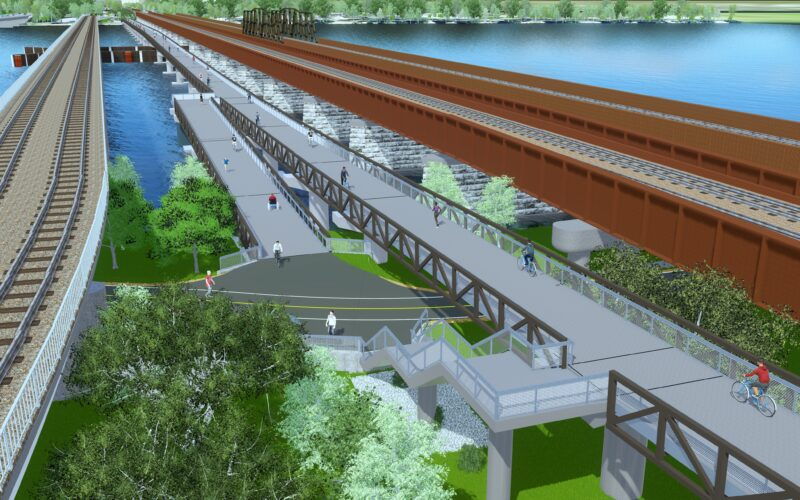Have a story idea
Have a story idea? Send it to us here.

Source : Virginia Passenger Rail Authority
October 31, 2024
Author : Patty Allen
In a significant infrastructure milestone, Virginia has embarked on its largest rail expansion project, the $2.3 billion Long Bridge initiative.
This project, a crucial component of the state’s broader Transforming Rail in Virginia (TRV) program, aims to significantly increase passenger rail capacity over the Potomac River, addressing a long-standing bottleneck between Arlington, Virginia, and Washington, D.C.
The groundbreaking ceremony, attended by the U.S. Secretary of Transportation Pete Buttigieg and prominent Virginia lawmakers such as Senators Tim Kaine and Mark Warner, marks the start of a long-term effort to enhance the state’s rail network.
The centerpiece of the project is the construction of a new two-track railroad bridge, which will run parallel to the existing, 119-year-old Long Bridge. As the existing bridge operates at 98?pacity during peak periods, the new infrastructure is expected to relieve this congestion, improving both passenger and freight rail operations along the East Coast.
The Long Bridge Project plays a pivotal role in VPRA’s overarching vision to improve rail services not only within Virginia but also for travelers across the U.S. East Coast. As DJ Stadtler, Executive Director of the Virginia Passenger Rail Authority (VPRA), highlighted during the ceremony, “Travelers from Boston to Miami will feel the effects of this project.” The expanded capacity is expected to support growing ridership, both for Virginia’s Amtrak service and the Virginia Railway Express (VRE), which offers commuter services in the region.
The TRV initiative, as a whole, promises to transform Virginia’s rail system by utilizing existing rail corridors and expanding infrastructure. This will allow Amtrak Virginia to increase its daily round trips from eight to thirteen, ensuring greater connectivity between cities such as Norfolk, Richmond, Roanoke, and Lynchburg. Additionally, the initiative is forecast to add $7.2 billion to the state’s economy, creating thousands of jobs and fostering economic growth in the region.
The Long Bridge Project will unfold in two primary phases. The first, known as the “South Package,” covers the Virginia portion and includes the construction of the new Potomac River rail bridge, as well as a parallel bicycle-pedestrian bridge.

The second, the “North Package,” will address the complex construction area on the D.C. side, involving several smaller bridges, such as the replacement of the two-track Ohio Drive SW rail bridge and the construction of a four-track Washington Channel rail bridge.
While site preparations are set to begin in the coming weeks, large-scale construction is expected to commence in 2025, with completion slated for 2030. The existing Long Bridge, which currently handles over 76 trains daily, will remain in use during the construction phase, helping minimize disruptions to current rail services. Once completed, the new bridge will help separate freight and passenger rail traffic, leading to improved reliability for both sectors.
One of the key motivations behind the Long Bridge Project is to provide Virginians with alternatives to driving on heavily congested highways and interstates.
“In Virginia, our crippling traffic has truly become a bipartisan issue, and the Long Bridge groundbreaking represents our bipartisan solution,” Stadtler said.
By expanding rail capacity, Virginia aims to reduce reliance on cars, thus alleviating traffic congestion and lowering carbon emissions.
Virginia’s investment in rail infrastructure is part of a larger vision to develop one of the most advanced passenger rail networks in the country. Since launching its first state-supported train in 2009, Virginia has rapidly expanded its Amtrak service. In 2023 alone, Amtrak Virginia saw over 1.32 million passengers, with ridership continuing to grow. The Long Bridge Project is a key component of this vision, ensuring that the state’s rail network can handle future demand.
Category : Investment in Infrastructure State Government Bridges
